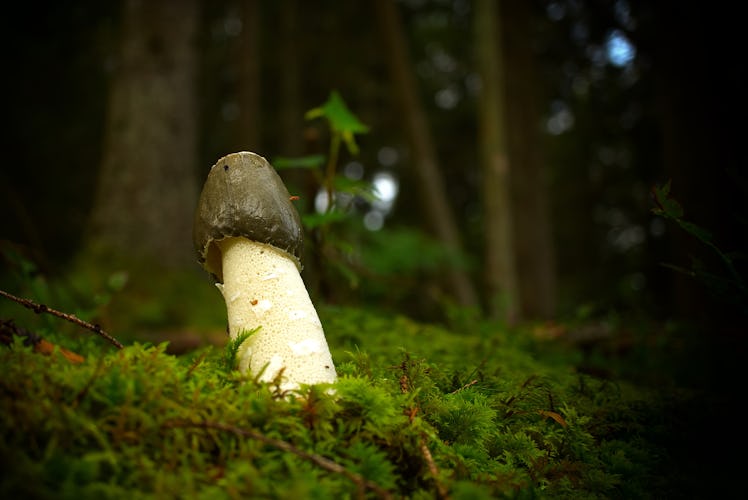Why Is The Penis Mushroom-Shaped?
It may have to do with female infidelity.

Penises come in all shapes and sizes, but one thing most have in common is a toadstool-like head, scientifically known as the glans. Whether short or long, thick or thin, circumcised or not, penises tends to look a bit like everyone’s favorite fungi. But why is the penis mushroom-shaped? Why does the tip make us think of shrooms? One leading theory is that the mushroom lookalike at the tip of the penis evolved because it’s a good shape for scooping out other men’s semen, says Gordon Gallup Ph.D., an evolutionary psychologist at the University at Albany in New York. This gives a new guy a better chance of getting a woman pregnant if she’s had sex with multiple partners in a short period of time.
“The mushroom configuration of the human penis evolved as an adaptation to female infidelity. And the evolutionary problem that's posed by female infidelity is that males can be duped into caring for offspring other than their own,” says Gallup, who popularized the so-called semen displacement theory with a co-authored study, published in 2003 — a theory that has since been backed up by other experts, such as Todd Shackelford, Ph.D., chair of psychology at Oakland University in Michigan.
“If a female has been inseminated by another male within a brief period of time, the next male in sequence has the opportunity to scoop out or displace the prior male’s semen from the female's reproductive tract, so he can substitute his semen for those of his rivals,” says Gallup. “It's called the semen displacement hypothesis.”
To establish this theory, Gallup’s team closely observed three differently shaped latex penises entering an artificial vagina filled with starch and water, used to represent semen.
The researchers found that the penises with a more pronounced “mushroom shape” — those that had a marked coronal ridge, where the head meets the shaft — fared better in the experiment. The most mushroom-shaped penis scooped out nearly 87% of prior sperm, while the least mushroom-shaped phallus of the three removed 40% of the sperm.
When asked if this means you can also scoop out your own semen in any movement following ejaculation, Gallup notes that, after insemination, thrusting becomes noticeably shallower and less vigorous. The penis quickly shrinks and stays limp as it exits the vagina — factors which hinder its scooping abilities, and possibly avoid self-sabotage.
And although it might seem unlikely that a woman would have sex with multiple men in a short enough time period to give mushroom-shaped members an evolutionary edge, Gallup believes otherwise. “In response to the question, have you ever had sex with two or more males within a 24-hour period on one or more occasions, one in in four [women] indicate that they have,” says Gallup, drawing on data from a 2004 study he published to support the semen displacement hypothesis. Throughout the long eras of our human evolution, this practice was probably even more common, he says.
Mushrooms, But Also Length, Power, Hooks, and Spines
The mushroom shape’s ability to scoop out semen is, of course, dependent on many other factors affecting sex, including thrusting depth and power, and length of the penis. “Deeper thrusting displaces more semen than shallow thrusting,” says Gallup. “And males with longer penises can deposit their semen in the most remote parts of the female vagina, therefore making displacement by [later] males less likely.”
Circumcision, too, may play a role in the modern world. Circumcised penises not only have a slightly more accentuated mushroom shape, but as a result of being circumcised, the head of the penis is less sensitive, according to Gallup. Therefore, when circumcised men have sex, they engage in deeper and more vigorous thrusting, which would be more likely to displace a previous lover’s semen, Gallup says.
Not everybody in the world of urology agrees with Gallup’s theory though. Some of the counterpoints raised by opposing experts include that there are surely many other factors at play, and that just because a mushroom-shaped penis is good at scooping semen doesn’t mean that’s why it’s shaped that way. Something else entirely could be the evolutionary cause, and the semen displacement could just be an added bonus. Some experts have gone as far to say that the theory seems “far-fetched.”
Yet Gallup’s theory is still to be debunked. “There is theoretical and empirical evidence consistent with the hypothesis that the head of the human penis is mushroom-shaped to facilitate displacement of a recent ejaculate deposited by a rival male,” says Shackelford, who has also conducted research in this field.
One study Shackelford published in 2016 showed that husbands whose wives spent more time with male friends — who the husbands may have seen as potential sexual rivals, consciously or not — actually carried out more semen-displacing behaviors when having sex with their wives, such as by thrusting harder.
It doesn't come as a surprise that the mushroomed penis allows one’s sperm to win the fatherhood race, according to Justin Houman, M.D., medical director for Bastion Health and a practicing urologist at Tower Urology at Cedars-Sinai Medical Center in Los Angeles, who was not involved in the study. “Animals have similar adaptations, such as penile barbs, hooks, combs, or a textured penis to displace other’s semen out of the vagina,” Houman explains.
For example, the honey badger’s penis bone — yes, most mammals have a bone in their penis — basically looks like an ice cream scooper. Domestic cats have penile spines that can help break through any sperm already inside the female’s body from another mate. And, according to a 2013 study, Neanderthals also used to have spiny penises.
So, for your partner’s sake, just be glad that spines and barbs aren’t the traits that won out in the evolution of the human penis.
This article was originally published on